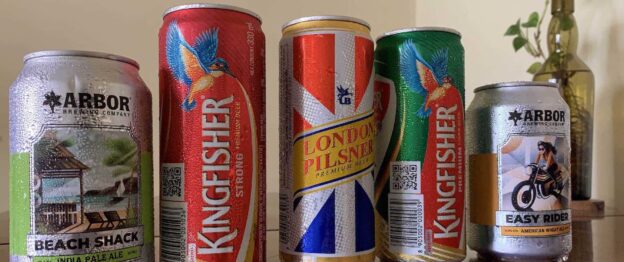India’s beer industry is facing a shortage of aluminium cans, thus impacting the sales of canned beer. As per some estimates in the media the short supply could be around 12 to 13 crore and the beer industry is finding it difficult to keep up with the demand.
United Breweries Limited (UBL), a leading beer manufacturer and part of HEINEKEN Company, has confirmed that packaging delays have led to a 1 to 2 percentage point loss in growth of beer over the past six months. The Managing Director and CEO of UBL, Vivek Gupta in a Q1 FY26 earnings call mentioned that cans represent 22% of their overall business but are critical in key markets.
The limited production capacity of India’s three domestic can manufacturing plants, two owned by international giants Poland-based Canpack and US-based Ball Beverage Packaging, have affected the supply chain. All aluminium used for cans is imported, as the specific gauge required is not produced domestically, further straining supply chains. According to a source, Ball Beverage is planning capacity expansion and ‘talks are going on’, similarly Canpack which is the market leader is also investing in capacity. While capacity is one aspect, the industry is facing challenges from the Bureau of Indian Standards (BIS) with regard to certification, as the process is adding to delays, the source added.
Surging Demand, Continue to Import
The situation on the ground is that production capacities have not kept pace with demand. Though India is the second-largest aluminium producer globally, yet its domestic manufacturing alone can’t meet surging demand across industries, from construction to automotive and packaging.
In FY2025, imported aluminium accounted for a staggering 54–56% of India’s total consumption, highlighting deep import dependence.
Canned Beer Revenues Still Healthy
Despite the strained supply chain, revenues from canned beer segment are impressive. Research from WantStats Media indicates that the revenue of the Indian beer market by packaging type in 2024 was approximately $16.25 billion from Cans and $18.45 billion from Bottles. So, in value and volume terms, bottlesled the market, a market which is predominantly a glass-bottle market.
The cans segment is growing fast due to various features such as convenience of carrying, faster cooling, high recycling rate, blocks UV rays etc. The soaring demand, competition from soft drinks market and new BIS (Bureau of Indian Standards) certification rules have been impacting production, causing stock-outs and lost growth, albeit temporarily.
Overall Demand Up
Overall, the demand for beer continues to grow. According to the Brewers Association of India (BAI), sales volume of beer went up to 450 million cases in 2024-25, up from 405 million cases the previous year. The nearly 10% increase in 2024-25 from the previous financial year, highlights the love for the ale by the consumer in India, a country largely known for drinking whisky.
Despite the supply chain hiccups, packaging in India has undergone a massive transformation. It is reported that the aluminium beverage can segment recorded a CAGR of 8.5% between 2019 and 2023, with forecasts suggesting a healthy 7.8% annual growth through 2032. It is indicated that the canned beer format is expected to grow at roughly 7.9% CAGR between 2025 and 2034. Expansions in production facilities are going to help in meeting the rising demand, though the pace of consumption presently is outstripping supply.
AGI Greenpac’s foray into cans
As per Persistence Market Research the Indian aluminium beverage can market (includes soft drinks manufacturers too) will double from $0.4 billion in 2025 to $0.8 billion by 2032, highlighting the immediacy for expanded capacity.
Gauging this, a leading manufacturer of glass and plastic containers, AGI Greenpac has made a bold play of getting into the aluminium can segment too. In July this year, AGI Greenpac announced that it would invest `1,000 crore in aluminium can manufacturing. The company is setting up a manufacturing facility in Uttar Pradesh with plans to produce 1.6 billion aluminium beverage cans annually. The rollout will happen in two phases: the first stage, adding 950 million cans per year, expected to go operational by the third quarter of FY 2027-28 and the full capacity timeline is March 2030.

The Chairman and Managing Director Sandip Somany has said, “This new venture offers strong synergies with our existing glass packaging business. Both categories serve the alcohol and F&B industries, allowing for leveraging existing customer relationships, distribution networks and supply chain efficiencies.”
Craft Beer Segment has a role too
The company has sensed the market which at one time considered canned beers a niche market, but now is quite the in thing as urban consumers seek convenience and sustainable choices. The craft beer market has had a role in this too as brands such as Bira91 and Kingfisher introduced canned offerings (Kingfisher Ultra Witbier in cans launched in Nov 2023) targeting urban millennials and Gen Z consumers in Bengaluru, Delhi, and Mumbai. Pushing sales up were e-commerce platforms as canned beer was unbreakable, lightweight, portable and fully recyclable. For beer companies it allowed them to announce product freshness while having the scope to play with distinctive designs to enhance brand appeal.

Smaller and craft beer brands, like Simba Beer, are particularly hard-hit, as larger brewers dominate the limited supply. Ishwaraj Singh Bhatia, Co-founder & COO of Simba Beer, has noted that cans drive significant off-premise and quick-commerce revenues. To mitigate the shortage, Simba has secured local can suppliers at higher costs and is exploring keg distribution in markets like Maharashtra and Goa, alongside expanding bottle formats to reduce reliance on cans.
Industry experts argue that backward integration, such as investing in new can manufacturing units, is not a viable solution for brewers due to high costs and expertise requirements. While new can plants are expected in the next couple of years, the immediate pressure on supply chains will persist, forcing brands to balance margins with consumer demand. Until capacity expands, the competition for cans is likely to remain intense, leaving smaller players with little bargaining power and pushing them toward more flexible packaging strategies.
BIS Certification, Slows Processes
Another factor that is affecting the supply chain is the introduction of the Bureau of Indian Standards (BIS) certification for aluminium cans which came into effect from April 1, 2025. The new Quality Control Orders (QCOs) require both domestic and imported cans to meet national standards, but the certification process is slow, often requiring inspections of overseas manufacturing plants. Vinod Giri, Director General of the Brewers Association of India (BAI), pointed out that international suppliers like Ball and Canpack face delays in shipping cans to India due to pending certifications.
The BAI has urged that the certification requirement be postponed to April 1, 2026, or exempt imported cans while allowing suppliers with pending applications to continue operations.
This supply constraint comes at a time when demand for canned beer is rising sharply, putting pressure on both brewers and retailers. The shortage is being driven by a mix of factors: global aluminium prices have turned volatile due to energy costs and geopolitical disruptions; India still depends heavily on imported beverage cans, so delays at ports or supply shocks quickly ripple through the market; peak consumption months such as March to June and October to December stretch supplier capacity even further; and, since COVID, a wide range of beverages—from energy drinks to ready-to-drink cocktails—are competing for the same limited can supply.
This supply constraint has emerged at a time when demand for canned beer is on a strong upswing, squeezing both brewers and retailers. Retailers are struggling to maintain inventory consistency, while they are keen on providing what the consumer wants.
This is indeed crucial considering that the annual per capita beer consumption in India is barely 2 litres and has ample room to grow compared to global averages. India’s overall beer market is projected to grow to 802.5 billion by 2033. Within this, the canned beer is set to outpace the broader category, fuelled by lifestyle changes, rising disposable incomes, and the continued spread of online alcohol sales, provided the supply chain falls in place.
Highlights:
BIS Standards for Aluminium Beverage Cans
IS 14407:1996: Specifies technical requirements and testing methods for aluminium beverage cans. It includes criteria such as material composition, coatings, seam integrity, pressure resistance, leakage prevention, and chemical stability. It applies to seamless two-piece drawn and wall-ironed (DWI) cans, impact-extruded, and ironed types, up to 500 ml capacity—intended for beer and carbonated beverages.
Certification under this standard ensures beverage freshness, consumer safety, recyclability, and regulatory compliance.
Certification Process & Timeline
Scheme: Covered under Product Certification Scheme (ISI Mark, Scheme I – Schedule 2) and is mandatory.
Testing Requirements: Rigorous testing is conducted for Material composition; Internal/external coating adherence; Seam and pressure resistance; Leakage prevention; and Impact resistance and chemical stability.
Timeline: Domestic (Indian) manufacturers: about 30 days and foreign manufacturers: about 180 days.

